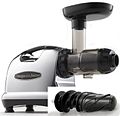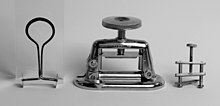Juicer
Juicers are used to extract juices from fruits , vegetables , herbs or grasses . They can be divided into three categories: juicers, centrifugal juicers, and steam extractors.
Juicer types
Juicers
Juicers use mechanical pressure to separate the juice from the pomace . One can differentiate between
- Citrus presses ,
- Juicers with one screw or with two counter-rotating screws
- or with counter-rotating toothed rollers
- as well as wine press ( wine presses , fruit presses , oil presses ).
Citrus presses can only juice citrus fruits, pomegranates or tropical nuts with soft pulp and tough skin (such as passion fruits , guavas or kiwanos ). They represent a very simple form of a juicer. They usually have a spherical cone that tapers to a point and is provided with angular ribs. With some devices the cone is rotated around the cone axis , with some devices it is rigid. So-called orange juicers halve and squeeze oranges fully automatically.
Juicers with one or two auger can juice almost any fruit and vegetable, but also herbs and grasses (for example with wheatgrass juice ). Sheets are most efficiently pressed with two counter-rotating toothed worm or toothed roller gears. In screw presses, the screws first break off pieces of the pressed material and then squeeze them out. The juice is forced through a sieve while the pomace is ejected at the end of the auger. The speed of the screw shafts is low, which is why little oxygen is injected into the juice. Therefore, the quality of the juice remains high.
Sugar cane presses extract juice through counter-rotating toothed rollers (moved like a spur gear ), between which the sugar cane is squeezed. This means that ginger and citrus fruits (with the release of peel oil) are also juiced as an addition to sugar cane juice.
Centrifuge juicer
With centrifuge juicers, the product to be juiced is rubbed by means of a central friction disk and the juice released in this way is strained through sieve plates using centrifugal force . The sieves are arranged in the shape of a cylinder or a truncated cone on the outer circumference of the friction disk . The friction disc rotates at high speed and shreds the raw material. As a result, the pomace is thrown against the sieves and the juice passes through the sieve slots.
Older models in particular have cylindrical sieves in which the pomace collects within and then has to be removed by hand. Since the pomace remains in the sieve for a long time and is centrifuged or pressed through the sieves with the help of a scraper, the juice yield is greater. Newer models have conical screens. As a result, the pomace is flung out of the sieve via the ejection opening into a container without any further action. Since the pomace is not spun for so long, the juice yield is lower.
Centrifugal juicers can juice very quickly and are therefore often used in the catering industry. They should be able to be dismantled without tools for subsequent cleaning.
Centrifugal juicers are good for juicing hard-cut fruits and vegetables. Leaf vegetables, grasses and berries or tough root vegetables or ginger , on the other hand, are difficult to process.
Steam extractor
Steam juicers are suitable for processing several kilograms of fruit. They usually consist of three parts: The lower flat container is filled with water to generate steam. A cambered collecting container is placed on top . The collecting container has a drain to which a hose is connected which is squeezed together by a clamp ( pinch valve ). In the middle of the collecting container there is an opening which is surrounded by a raised edge so that steam can rise from the lower part, but the fruit juice remains in the collecting container. The perforated fruit basket is placed in the collecting container. This sometimes has the shape of a funnel that tapers upwards. The whole juicer is closed with a lid, with newer juicers this is usually made of glass so that the process can be observed (provided the lid does not fog up with condensation) without having to remove the lid, which wastes steam and thus energy or time went.
When juicing, the water in the lower container is brought to the boil, the hot steam rises in the middle through the opening in the collecting container up into the fruit basket. The heat of the steam and any added sugar cause the plant cells to burst, the product to be juiced is macerated on the one hand and subjected to steam distillation (the steams are controlled in such a way that as much of the steam as possible is condensed in the juice formed and few aromatic substances are entrained with steam ). The juice flows through the holes in the fruit basket into the collecting container according to the principle of communicating tubes . After the fruit has been juiced and the juice has been heated sufficiently for preservation , the hose clamp is released so that the juice can be filled from the collecting container into clean, sterilized containers (bottles, glasses).
Since there is no movement, unwanted residues such as nuclei remain. Skins and stems in the fruit basket. The workload is low. The resulting, diluted juice has a long shelf life, but because of the longer heating it has a poorer flavor (than, for example, pressed juice and pasteurized before bottling or in the bottle ). The disadvantage is the relatively high energy consumption for generating the steam, and the juicing process also takes a relatively long time, although this time can usefully be used for other work, since the process takes place without any further action.
Many manufacturers offer steam extractors that can be used in individual components as a large saucepan or for steaming vegetables, and there are also special inserts for canning pots with which they can also be used as steam extractors. In addition to steam juicers for use on the stove, models with built-in electric heating are also available that can be plugged into any socket and therefore also be used outside the kitchen.
Quality and quantity of the juices
The quality of the juice depends on the amount of oxygen introduced during juicing and the temperature used. Fast-running juicers, stand mixers or hand blenders swirl a relatively large amount of air and thus oxygen into the juice, which can lead to faster oxidation of the ingredients (see also enzymatic browning ) and a reduction in quality. Digestive enzymes contained in the juice are significantly reduced by the swirling of oxygen in centrifuge juicers. Due to the increased temperature, steam extractors destroy some of the vitamins and most of the enzymes. Juicers swirl little oxygen into the juice and hardly heat the juice, so they juice the most gently and deliver a juice of the highest quality.
With cold production, the amount of juice produced depends on the degree of crushing and the pressing force. Since centrifugal juicers grate relatively finely, some achieve a high juice yield. But juicers can also achieve a high yield simply by applying great pressure. There are big differences from manufacturer to manufacturer.
The following images show apple juice from a screw juicer on the left and apple juice from a centrifuge juicer on the right.
See also
- Wine press - juicer for large quantities, e.g. B. for wine or cider
- Fleet Lotte
- Blender
- Hand blender
Web links
Individual evidence
- ^ A b Comparison of Juice Extractors: Enzymes , Michael Donaldson, Ph.D., Hallelujah Acres Foundation, Shelby.











